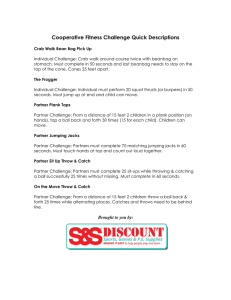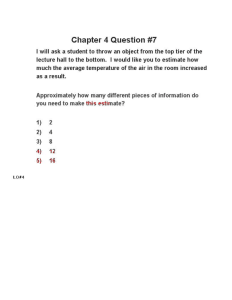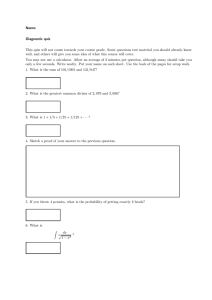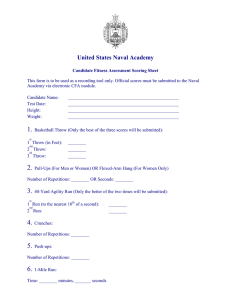Embodied Models of Language Learning and Use Embodied language learning Nancy Chang
advertisement
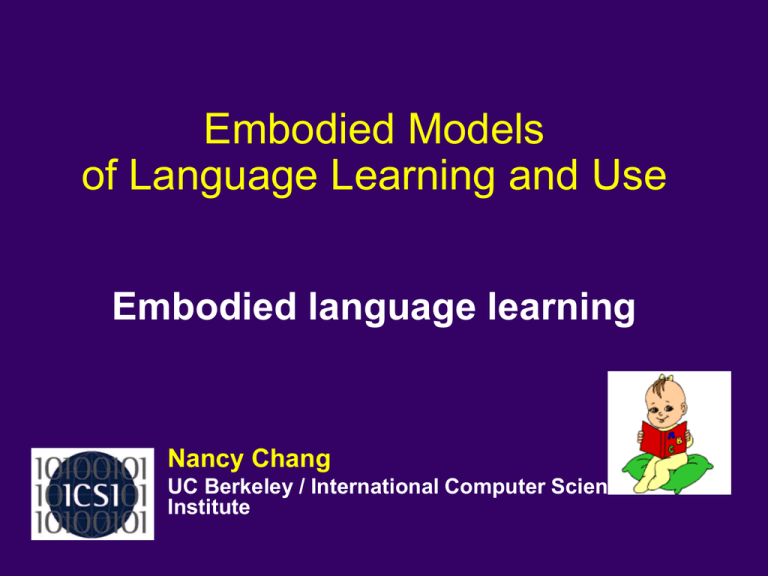
Embodied Models of Language Learning and Use Embodied language learning Nancy Chang UC Berkeley / International Computer Science Institute Turing’s take on the problem “Of all the above fields the learning of languages would be the most impressive, since it is the most human of these activities. This field seems however to depend rather too much on sense organs and locomotion to be feasible.” Alan M. Turing Intelligent Machinery (1948) Five decades later… Sense organs and locomotion – Perceptual systems (especially vision) – Motor and premotor cortex – Mirror neurons: possible representational substrate – Methodologies: fMRI, EEG, MEG Language – Chomskyan revolution – …and counterrevolution(s) – Progress on cognitively and developmentally plausible theories of language – Suggestive evidence of embodied basis of language …it may be more feasible than Turing thought! (Maybe language depends enough on sense organs and locomotion to be feasible!) From single words to complex utterances FATHER: Nomi are you climbing up the books? NAOMI: up. NAOMI: climbing. NAOMI: books. 1;11.3 MOTHER: what are you doing? NAOMI: I climbing up. MOTHER: you’re climbing up? 2;0.18 FATHER: what’s the boy doing to the dog? NAOMI: squeezing his neck. NAOMI: and the dog climbed up the tree. NAOMI: now they’re both safe. NAOMI: but he can climb trees. 4;9.3 Sachs corpus (CHILDES) How do they make the leap? 0-9 months 18-24 months Smiles Responds differently to intonation Responds to name and “no” agent-object 9-18 months First words Recognizes intentions Responds, requests, calls, greets, protests – Daddy cookie – Girl ball agent-action – Daddy eat – Mommy throw action-object – Eat cookie – Throw hat entity-attribute – Daddy cookie entity-locative – Doggie bed The logical problem of language acquisition Gold’s Theorem: Identification in the limit No superfinite class of language is identifiable from positive data only The logical problem of language acquisition Natural languages are not finite sets. Children receive (mostly) positive data. But children acquire language abilities quickly and reliably. One (not so) logical conclusion: THEREFORE: there must be strong innate biases restricting the search space Universal Grammar + parameter setting But kids aren’t born as blank slates! And they do not learn language in a vacuum! Note: class of probabilistic contextfree languages is learnable in the limit!! I.e., from hearing a finite number of sentences, Baby can correctly converge on a grammar that predicts an infinite number of sentences. – Model is generalizing! Just like real babies! What is knowledge of language? Basic sound patterns (Phonology) How to make words (Morphology) How to put words together (Syntax) What words (etc.) mean (Semantics) How to do things with words(Pragmatics) Rules of conversation (Pragmatics) Grammar learning is driven by meaningful language use in context. All aspects of the problem should reflect this assumption: – Target of learning: a construction (form-meaning pair) – Prior knowledge: rich conceptual structure, pragmatic inference – Training data: pairs of utterances / situational context – Performance measure: success in communication (comprehension) Correlating forms and meanings FORM (sound) “you” lexical constructions you MEANING (stuff) Qu ic kTi me™ a nd a TIFF (U nc omp res se d) de co mpre ss or are n ee de d to se e thi s p i cture . Human “throw” throw Throw thrower throwee “ball” “block” ball block Object Language Acquisition Opulence of the substrate – Prelinguistic children already have rich sensorimotor representations and sophisticated social knowledge – intention inference, reference resolution – language-specific event conceptualizations (Bloom 2000, Tomasello 1995, Bowerman & Choi, Slobin, et al.) Children are sensitive to statistical information – Phonological transitional probabilities – Most frequent items in adult input learned earliest (Saffran et al. 1998, Tomasello 2000) cow apple ball juice bead girl bottle truck baby w oof yum go up this no m ore m ore spoon ham m er shoe d ad d y m oo w hee get out there bye banana box eye m om y uhoh sit in here hi cookie horse d oor boy choochoo boom oh open on that no food toys yes misc. people d ow n sound emotion action prep. demon. social Words learned by most 2-year olds in a play school (Bloom 1993) Early syntax agent + action ‘Daddy sit’ action + object ‘drive car’ agent + object ‘Mommy sock’ action + location ‘sit chair’ entity + location ‘toy floor’ possessor + owned ‘my teddy’ entity + attribute ‘crayon big’ Demonst.+ entity ‘this phone’ Language Acquisition Basic Scenes – Simple clause constructions are associated directly with scenes basic to human experience (Goldberg 1995, Slobin 1985) Verb Island Hypothesis – Children learn their earliest constructions (arguments, syntactic marking) on a verb-specific basis (Tomasello 1992) throw frisbee get ball throw ball get bottle … … throw OBJECT get OBJECT Children generalize from experience push12 push3 force=high … push34 force=low force=? Specific cases are learned before general throw frisbee drop ball throw ball drop bottle … … throw OBJECT drop OBJECT Earliest constructions are lexically specific (itembased). (Verb Island Hypothesis, Tomasello 1992) Development Of Throw 1;2.9 1;8.0 1;10.11 1;10.28 1;11.3 1;11.3 1;11.9 don’t throw the bear. Contextually throw grounded throw off Parental don’t throw them on the ground. utterances I throwded it. (= I fell) more I throwded. (= I fell) complex Nomi don’t throw the books down. what do you throw it into? I throw it. what did you throw it into? I throw it ice. (= I throw the ice) they’re throwing this in here. throwing the thing. throwing in. throwing. Development Of Throw (cont’d) 2;0.3 2;0.5 2;0.18 2;1.17 2;5.0 2;11.12 don’t throw it Nomi. can I throw it? I throwed Georgie. could I throw that? Nomi stop throwing. throw it? well you really shouldn’t throw things Nomi you know. remember how we told you you shouldn’t throw things. you throw that? gonna throw that? throw it in the garbage. throw in there. throw it in that. I throwed it in the diaper pail. How do children make the transition from single words to complex combinations? Multi-unit expressions with relational structure Concrete word combinations Item-specific constructions (limited-scope formulae) fall down, eat cookie, Mommy sock X throw Y, the X, X’s Y Argument structure constructions (syntax) Grammatical markers Tense-aspect, agreement, case Language learning is structure learning “You’re throwing the ball!” Intonation, stress Phonemes, syllables Morphological structure Word segmentation, order Syntactic structure Sensorimotor structure Event structure Pragmatic structure: attention, intention, perspective Stat. regularities Making sense: structure begets structure! Structure is cumulative Object recognition scene understanding Word segmentation word learning Language learners exploit existing structure Learners exploit existing structure to make sense of their environment Achieve goals communicative goals Infer communicative intentions intentions Exploiting existing structure “You’re throwing the ball!” Comprehension is partial. (not just for dogs) What we say to kids… What they hear… what do you throw it into? they’re throwing this in here. do you throw the frisbee? they’re throwing a ball. don’t throw it Nomi. blah blah YOU THROW blah? blah THROW blah blah HERE. blah YOU THROW blah blah? blah THROW blah blah BALL. DON’T THROW blah NOMI. well you really shouldn’t throw things Nomi you know. remember how we told you you shouldn’t throw things. blah YOU blah blah THROW blah NOMI blah blah. blah blah blah blah YOU shouldn’t THROW blah. But children also have rich situational context/cues they can use to fill in the gaps. Understanding drives learning Utterance+Situation Linguistic knowledge Conceptual knowledge Understanding Learning (Partial) Interpretation Potential inputs to learning Genetic language-specific biases Domain-general structures and processes Embodied representations …grounded in action, perception, conceptualization, and other aspects of physical, mental and social experience Talmy 1988, 2000; Glenberg and Robertson 1999; MacWhinney 2005; Barsalou 1999; Choi and Bowerman 1991; Slobin 1985, 1997 Social routines Intention inference, reference resolution Statistical information transition probabilities, frequency effects Usage-based approaches to language learning (Tomasello 2003, Clark 2003, Bybee 1985, Slobin 1985, Goldberg 2005) …the opulence of the substrate! Models of language learning Several previous models of word learning are grounded (form + meaning) – – – – – Regier 1996: <bitmaps, word> spatial relations Roy and Pentland 1998: <image, sound> object shapes/attributes Bailey 1997: <feature structure, word> actions Siskind 2000: <video, sound> actions Oates et al. 1999: <sensors, word class> actions Not so for grammar learning! – Stolcke 1994: probabilistic attribute grammars from sentences – Siskind 1996: verb argument structure from predicates – Thompson 1998: syntax-semantics mapping from database queries Representation: constructions The basic linguistic unit is a <form, meaning> pair (Kay and Fillmore 1999, Lakoff 1987, Langacker 1987, Goldberg 1995, Croft 2001, Goldberg and Jackendoff 2004) ball toward Big Bird throw-it Relational constructions throw ball construction THROW-BALL constituents t : THROW o : BALL form tf before of meaning tm.throwee om Embodied Construction Grammar (Bergen & Chang, 2005) Usage: Construction analyzer Utterance+Situation Conceptual knowledge Linguistic knowledge (embodied schemas) (constructions) Understanding (Partial) Interpretation (semantic specification) Partial parser Unification-based Reference resolution (Bryant 2004) Usage: best-fit constructional analysis Utterance Discourse & Situational Context Constructions Analyzer: probabilistic, incremental, competition-based Semantic Specification: image schemas, frames, action schemas Simulation Competition-based analyzer finds the best analysis An analysis is made up of: A constructional tree A set of resolutions A semantic specification The best fit has the highest combined score An analysis using THROW-TRANSITIVE Usage: Partial understanding “You’re throwing the ball!” ANALYZED MEANING PERCEIVED MEANING Participants: ball, Ego Participants: my_ball, Ego Throw-Action thrower = ? throwee = ? Throw-Action thrower = Ego throwee = my_ball Construction learning model: search Proposing new constructions Relational Mapping context-dependent Reorganization Merging (generalization) Splitting (decomposition) Joining (compositon) context-independent Initial Single-Word Stage FORM (sound) “you” “throw” lexical constructions “block” schema Addressee subcase of Human you throw “ball” ball block MEANING (stuff) schema Throw roles: thrower throwee schema Ball subcase of Object schema Block subcase of Object New Construction Hypothesized construction THROW-BALL constructional constituents t : THROW b : BALL form tf before bf meaning tm.throwee ↔ bm Context-driven relational mapping: partial analysis Context-driven relational mapping: form and meaning correlation Meaning Relations: pseudoisomorphism strictly isomorphic: Bm fills a role of Am shared role-filler: Am and Bm have a role filled by X sibling role-fillers: Am and Bm fill roles of Y Relational mapping strategies strictly isomorphic: – – Bm is a role-filler of Am (or vice versa) Am.r1 Bm A Af formrelation Bf throw ball Am rolefiller B Bm throw.throwee ball Relational mapping strategies shared role-filler: – – Am and Bm each have a role filled by the same entity Am.r1 Bm.r2 A Af Am formrelation Bf put ball down rolefiller X B Bm rolefiller put.mover ball down.tr ball Relational mapping strategies sibling role-fillers: – – Am and Bm fill roles of the same schema Y.r1 Am, Y.r2 Bm A Af Am formrelation Bf Nomi ball rolefiller Y B Bm rolefiller possession.possessor Nomi possession.possessed ball Overview of learning processes Relational mapping – throw the ball THROW < BALL Merging – throw the block – throwing the ball THROW < OBJECT Joining – throw the ball – ball off – you throw the ball off THROW < BALL < OFF Merging similar constructions FORM throw the block throw before Objectf throw the ball construction THROW-BLOCK subcase of THROW-OBJECT constituents o : BLOCK construction THROW-BLOCK constituents t : THROW o : BLOCK form tf before of meaning tm.throwee om THROW-OBJECT construction construction THROW-BALL constituents t : THROW o : BALL form tf before of meaning tm.throwee om construction THROW-OBJECT constituents t : THROW o : OBJECT form tf before of meaning tm.throwee om MEANING Throw thrower throwee Block THROW.throwee = Objectm Throw thrower throwee Ball construction THROW-BALL subcase of THROW-OBJECT constituents o : BALL Overview of learning processes Relational mapping – throw the ball THROW < BALL Merging – throw the block – throwing the ball THROW < OBJECT Joining – throw the ball – ball off – you throw the ball off THROW < BALL < OFF Joining co-occurring constructions FORM throw the ball throw before ball ball before off ball off construction THROW-BALL constituents t : THROW o : BALL form tf before of meaning tm.throwee om ThrowBallOff construction construction BALL-OFF constituents b : BALL o : OFF form bf before of meaning evokes Motion as m mm.mover bm mm.path om MEANING Throw thrower throwee Ball THROW.throwee=Ball Motion m m.mover = Ball m.path = Off Motion Ball mover path Off Joined construction construction THROW-BALL-OFF constructional constituents t : THROW b : BALL o : OFF form tf before bf bf before of meaning evokes MOTION as m tm.throwee bm m.mover bm m.path om Construction learning model: evaluation asdf Heuristic: minimum description length (MDL: Rissanen 1978) Learning:usage-based optimization Grammar learning = search for (sets of) constructions Incremental improvement toward best grammar given the data Search strategy: usage-driven learning operations Evaluation criteria: simplicity-based, informationtheoretic Minimum description length: most compact encoding of the grammar and data Trade-off between storage and processing Minimum description length (Rissanen 1978, Goldsmith 2001, Stolcke 1994, Wolff 1982) Seek most compact encoding of data in terms of Compact representation of model (i.e., the grammar) Compact representation of data (i.e., the utterances) Approximates Bayesian learning (Bailey 1997, Stolcke 1994) Exploit tradeoff between preferences for: smaller grammars Fewer constructions Fewer constituents/constraints Shorter slot chains (more local concepts) simpler analyses of data Fewer constructions More likely constructions Shallower analyses Pressure to compress/generalize Pressure to retain specific constructions MDL: details Choose grammar G to minimize length(G|D): length(G|D) = m • length(G) + n • length(D|G) Bayesian approximation: length(G|D) ≈ posterior probability P(G|D) Length of grammar = length(G) ≈ prior P(G) favor fewer/smaller constructions/roles favor shorter slot chains (more familiar concepts) Length of data given grammar = length(D|G) ≈ likelihood P(D|G) favor simpler analyses using more frequent constructions Flashback to verb learning: Learning 2 senses of PUSH Model merging based on Bayesian MDL Experiment: learning verb islands Question: – Can the proposed construction learning model acquire English item-based motion constructions? (Tomasello 1992) Given: initial lexicon and ontology Data: child-directed language annotated with contextual information Form: text : throw the ball intonation : falling Participants : Mother, Naomi, Ball Scene : Throw thrower : Naomi throwee : Ball Discourse : speaker :Mother addressee Naomi speech act : imperative activity : play joint attention : Ball Experiment: learning verb islands Subset of the CHILDES database of parent-child interactions (MacWhinney 1991; Slobin ) coded by developmental psychologists for – form: particles, deictics, pronouns, locative phrases, etc. – meaning: temporality, person, pragmatic function, type of motion (self-movement vs. caused movement; animate being vs. inanimate object, etc.) crosslinguistic (English, French, Italian, Spanish) – English motion utterances: 829 parent, 690 child utterances – English all utterances: 3160 adult, 5408 child – age span is 1;2 to 2;6 Annotated Childes Data 765 Annotated Parent Utterances Annotated for the following scenes: – – – – – CausedMotion : “Put Goldie through the chimney” SelfMotion : “did you go to the doctor today?” JointMotion : “bring the other pieces Nomi” Transfer :“give me the toy” SerialAction: “come see the doggie” Originally annotated by psychologists An Annotation (Bindings) Utterance: Put Goldie through the chimney SceneType: CausedMotion Causer: addressee Action: put Direction: through Mover: Goldie (toy) Landmark: chimney Learning throw-constructions INPUT UTTERANCE SEQUENCE 1. Don’t throw the bear. LEARNED CXNS throw-bear 2. you throw it 3. throw-ing the thing. 4. Don’t throw them on the ground. 5. throwing the frisbee. you-throw throw-thing throw-them throw-frisbee MERGE 6. Do you throw the frisbee? COMPOSE throw-OBJ 7. She’s throwing the frisbee. COMPOSE you-throw-frisbee she-throw-frisbee Example learned throw-constructions Throw bear You throw Throw thing Throw them Throw frisbee Throw ball You throw frisbee She throw frisbee <Human> throw frisbee Throw block Throw <Toy> Throw <Phys-Object> <Human> throw <Phys-Object> Early talk about throwing Transcript data, Naomi 1;11.9 Sample input prior to 1;11.9: don’t throw the bear. don’t throw them on the ground. Nomi don’t throw the books down. what do you throw it into? Sample tokens prior to 1;11.9: throw throw off I throw it. I throw it ice. (= I throw the ice) Par: Par: Child: Child: Par: Par: Child: Child: Child: Par: Child: they’re throwing this in here. throwing the thing. throwing in. throwing. throwing the frisbee. … do you throw the frisbee? do you throw it? throw it. I throw it. … throw frisbee. she’s throwing the frisbee. throwing ball. Sachs corpus (CHILDES) A quantitative measure: coverage Goal: incrementally improving comprehension – At each stage in testing, use current grammar to analyze test set Coverage = % role bindings analyzed Example: – Grammar: throw-ball, throw-block, you-throw – Test sentence: throw the ball. Bindings: scene=Throw, thrower=Nomi, throwee=ball Parsed bindings: scene=Throw, throwee=ball – Score test grammar on sentence: 2/3 = 66.7% Learning to comprehend Principles of interaction Early in learning: no conflict – Conceptual knowledge dominates – More lexically specific constructions (no cost) throw want throw off want cookie throwing in want cereal you throw it I want it Later in learning: pressure to categorize – More constructions = more potential for confusion during analysis – Mixture of lexically specific and more general constructions throw OBJ want OBJ throw DIR I want OBJ throw it DIR ACTOR want OBJ ACTOR throw OBJ Verb island constructions learned – Basic processes produce constructions similar to those in child production data. – System can generalize beyond encountered data with pressur to merge constructions. – Differences in verb learning lend support to verb island hypothesis. Future directions – full English corpus: non-motion scenes, argument structure constructions – Crosslinguistic data: Russian (case marking), Mandarin Chine (omission, directional particles, aspect markers) – Morphological constructions – Contextual constructions; multi-utterance discourse (Mok) Summary Model satisfies convergent constraints from diverse disciplines – Crosslinguistic developmental evidence – Cognitive and constructional approaches to grammar – Precise grammatical representations and data-driven learning framework for understanding and acquisition Model addresses special challenges of language learning – Exploits structural parallels in form/meaning to learn relational mappings – Learning is usage-based/error-driven (based on partial comprehension) Minimal specifically linguistic biases assumed – Learning exploits child’s rich experiential advantage – Earliest, item-based constructions learnable from utterance-context pairs Key model components Embodied representations – Experientially motivated rep’ns incorporating meaning/context Construction formalism – Multiword constructions = relational form-meaning correspondences Usage 1: Learning tightly integrated with comprehension – New constructions bridge gap between linguistically analyzed meaning and contextually available meaning Usage 2: Statistical learning framework – Incremental, specific-to-general learning – Minimum description length heuristic for choosing best grammar Embodied Construction Grammar Theory of Language Structure Theory of Language Acquisition Usage-based optimization Theory of Language Use Simulation Semantics Usage-based learning: comprehension and production discourse & situational context world knowledge utterance comm. intent constructicon analyze & resolve reinforcement (usage) hypothesize constructions & reorganize analysis simulation reinforcement (usage) reinforcement (correction) generate utterance reinformcent (correction) response A Best-Fit Approach for Productive Analysis of Omitted Arguments Eva Mok & John Bryant University of California, Berkeley International Computer Science Institute Simplifying grammar by exploiting the language understanding process Omission of arguments in Mandarin Chinese Construction grammar framework Model of language understanding Our best-fit approach Productive Argument Omission (in Mandarin) ma1+ma gei3 1 ni3 zhei4+ge mother give 2PS 2 3 You give auntie [the peach]. ni3 gei3 yi2 2PS give auntie ao ni3 EMP 4 this+CLS gei3 Mother (I) give you this (a toy). ya Oh (go on)! You give [auntie] [that]. 2PS give EMP gei3 [I] give [you] [some peach]. give CHILDES Beijing Corpus (Tardiff, 1993; Tardiff, 1996) Arguments are omitted with different probabilities % elided (98 total utterances) 100.00% 90.00% 80.00% Giver Theme 70.00% 60.00% 50.00% 40.00% 30.00% 20.00% 10.00% 0.00% All arguments omitted: 30.6% No arguments omitted: 6.1% Recipient Construction grammar approach Kay & Fillmore 1999; Goldberg 1995 Grammaticality: form and function Basic unit of analysis: construction, i.e. a pairing of form and meaning constraints Not purely lexically compositional Implies early use of semantics in processing Embodied Construction Grammar (ECG) (Bergen & Chang, 2005) Proliferation of constructions Subj Verb Obj1 Obj2 ↓ ↓ ↓ ↓ Giver Transfer Recipient Theme Verb Obj1 Obj2 ↓ ↓ ↓ Transfer Recipient Theme Subj Verb Obj2 ↓ ↓ ↓ Giver Transfer Theme Subj Verb Obj1 ↓ ↓ ↓ Giver Transfer Recipient … If the analysis process is smart, then... Subj Verb Obj1 Obj2 ↓ ↓ ↓ ↓ Giver Transfer Recipient Theme The grammar needs only state one construction Omission of constituents is flexibly allowed The analysis process figures out what was omitted Best-fit analysis takes burden off grammar representation Utterance Discourse & Situational Context Constructions Analyzer: incremental, competitionbased, psycholinguistically plausible Semantic Specification: image schemas, frames, action schemas Simulation Competition-based analyzer finds the best analysis An analysis is made up of: – A constructional tree – A set of resolutions – A semantic specification The best fit has the highest combined score Combined score that determines bestfit Syntactic Fit: – Constituency relations – Combine with preferences on non-local elements – Conditioned on syntactic context Antecedent Fit: – Ability to find referents in the context – Conditioned on syntactic information, feature agreement Semantic Fit: – Semantic bindings for frame roles – Frame roles’ fillers are scored Analyzing ni3 gei3 yi2 (You give auntie) Two of the competing analyses: ni3 ↓ Giver gei3 yi2 omitted ↓ ↓ ↓ Transfer Recipient Theme ni3 ↓ Giver gei3 omitted ↓ ↓ Transfer Recipient Syntactic Fit: – P(Theme omitted | ditransitive cxn) = 0.65 – P(Recipient omitted | ditransitive cxn) = 0.42 (1-0.78)*(1-0.42)*0.65 = 0.08 (1-0.78)*(1-0.65)*0.42 = 0.03 yi2 ↓ Theme Frame and lexical information restrict type of reference Transfer Frame Giver Lexical Unit gei3 Recipient Giver (DNI) Theme Recipient (DNI) Manner Means Place Purpose Reason Time Theme (DNI) Can the omitted argument be recovered from context? Antecedent Fit: ni3 gei3 yi2 omitted ↓ ↓ ↓ ↓ Giver Transfer Recipient Theme ni3 gei3 omitted yi2 ↓ ↓ ↓ ↓ Giver Transfer Recipient Theme Discourse & Situational Context child peach table mother auntie ? How good of a theme is a peach? How about an aunt? Semantic Fit: ni3 gei3 yi2 omitte d ↓ ↓ ↓ ↓ Giver Transf Recipie Theme er nt The Transfer Frame ni3 gei3 omitted yi2 ↓ ↓ ↓ ↓ Giver Transfer Recipien Theme t Giver (usually animate) Recipient (usually animate) Theme (usually inanimate) The argument omission patterns shown earlier can be covered with just ONE construction % elided (98 total utterances) 90.00% Subj Verb Obj1 Obj2 80.00% ↓ ↓ ↓ ↓ 60.00% Giver Theme 70.00% 50.00% Recipient 40.00% Giver Transfer Recipient Theme 30.00% 20.00% 10.00% 0.78 P(omitted|cxn): 0.42 0.65 0.00% Each construction is annotated with probabilities of omission Language-specific default probability can be set Leverage process to simplify representation The processing model is complementary to the theory of grammar By using a competition-based analysis process, we can: – Find the best-fit analysis with respect to constituency structure, context, and semantics – Eliminate the need to enumerate allowable patterns of argument omission in grammar This is currently being applied in models of language understanding and grammar learning. Language understanding as simulative inference “Harry walked to the cafe.” Utterance Linguistic knowledge Analysis Process General Knowledge Belief State Schema walk Trajector Harry Cafe Goal cafe Simulation Specification Simulation Usage-based learning: comprehension and production discourse & situational context world knowledge utterance comm. intent constructicon analyze & resolve reinforcement (usage) hypothesize constructions & reorganize analysis simulation reinforcement (usage) reinforcement (correction) generate utterance reinformcent (correction) response Recapituation Theory of Language Structure Theory of Language Acquisition Theory of Language Use Motivating assumptions Structure and process are linked – Embodied language use constrains structure! Language and rest of cognition are linked – All evidence is fair game Need computational formalisms that capture embodiment – Embodied meaning representations – Embodied grammatical theory Embodiment and Simulation: Basic NTL Hypotheses Embodiment Hypothesis – Basic concepts and words derive their meaning from embodied experience. – Abstract and theoretical concepts derive their meaning from metaphorical maps to more basic embodied concepts. – Structured connectionist models provide a suitable formalism for capturing these processes. Simulation Hypothesis – Language exploits many of the same structures used for action, perception, imagination, memory and other neurally grounded processes. – Linguistic structures set parameters for simulations that draw on these embodied structures. The ICSI/Berkeley Neural Theory of Language Project
